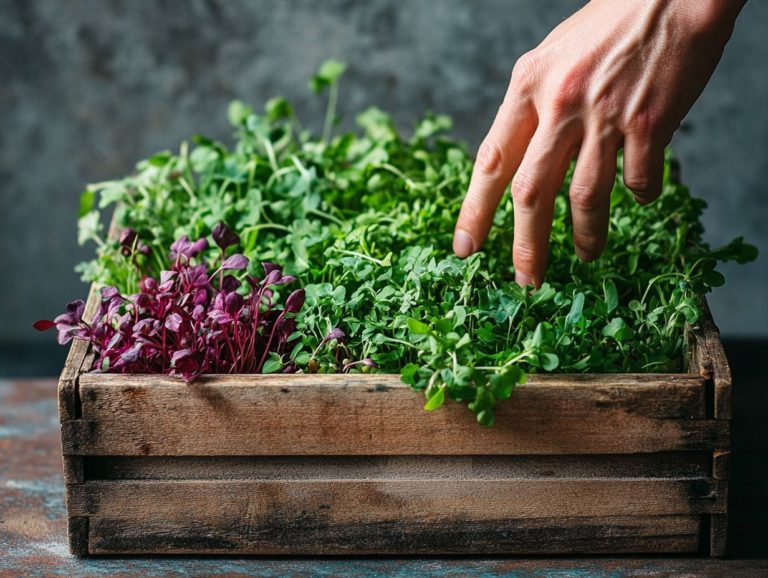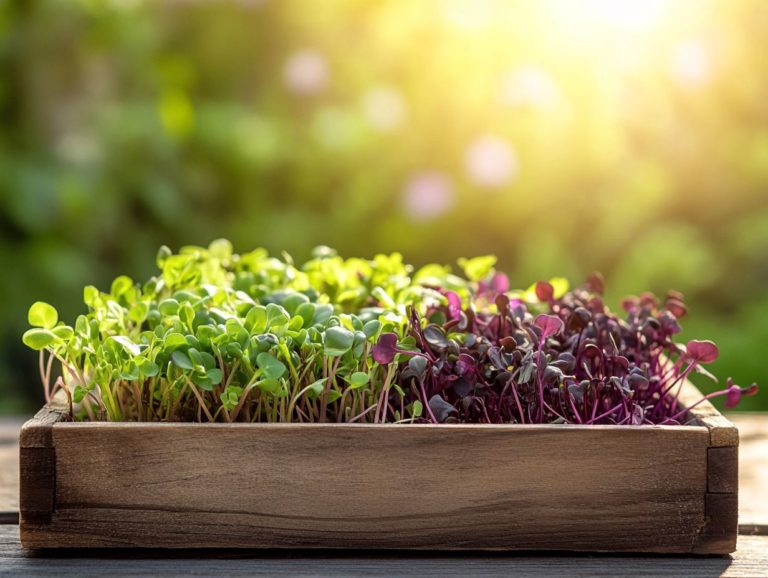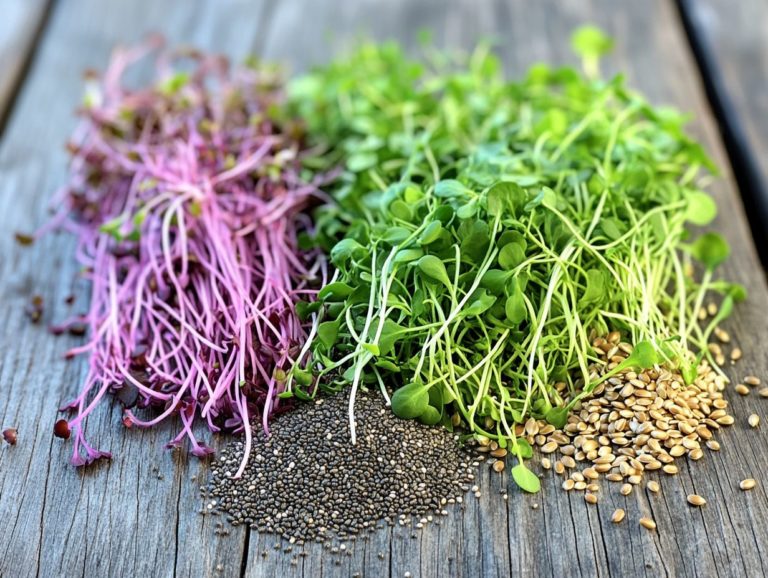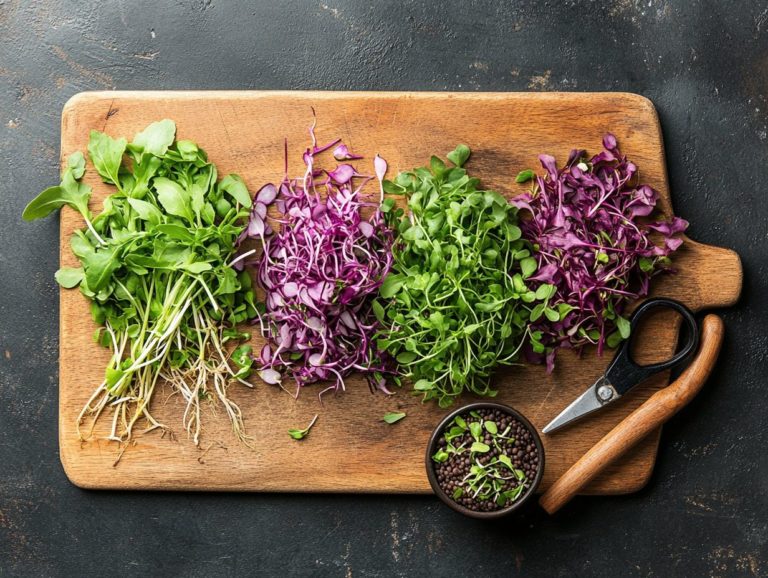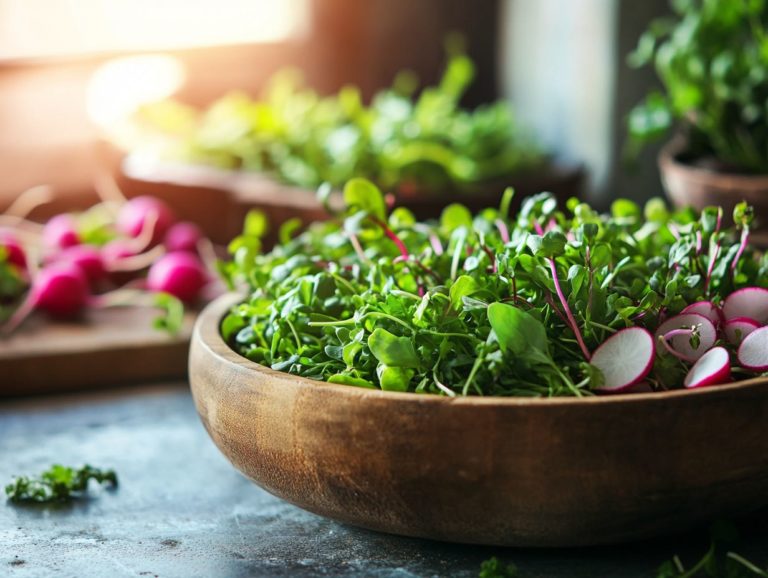5 Microgreens That Aid in Digestion
Microgreens are petite, nutrient-dense plants that have gained acclaim for their bold flavors and remarkable health benefits, offering a significant nutritional punch.
These tiny wonders can significantly improve your digestion, featuring varieties such as pea shoots, radish, cilantro, broccoli, and sunflower microgreens each one boasting distinct properties that support gut health while also providing concentrated nutrients.
You’ll find valuable tips on how to seamlessly incorporate these greens into your meals, along with insights into potential side effects and guidance on cultivating your own microgreens.
Embark on a journey to enhanced digestion by harnessing the incredible power of microgreens!
Contents
- Key Takeaways:
- 1. What Are Microgreens?
- 2. How Do Microgreens Aid in Digestion?
- 3. Pea Shoots
- 4. Radish Microgreens
- 5. Cilantro Microgreens
- 6. Broccoli Microgreens
- 7. Sunflower Microgreens
- 8. How to Incorporate Microgreens into Your Diet
- 9. Potential Side Effects of Microgreens
- 10. Are Microgreens Safe for Everyone?
- 11. How to Grow Your Own Microgreens
- 12. Other Health Benefits of Microgreens
- 13. Microgreens vs. Sprouts: What’s the Difference?
- 14. How to Choose and Store Microgreens
- Frequently Asked Questions
- 1. What are the top 5 microgreens that aid in digestion?
- 2. How do microgreens help with digestion?
- 3. Can microgreens relieve digestive issues?
- 4. How can I add microgreens to my meals?
- 5. Are there any precautions to take when consuming microgreens for digestion?
- 6. Can microgreens aid in weight loss and digestion at the same time?
Key Takeaways:

- Adding microgreens to your diet can aid in digestion by promoting the growth of beneficial bacteria in the gut.
- Pea shoots, radish microgreens, cilantro microgreens, broccoli microgreens, and sunflower microgreens are all beneficial for digestion.
- Microgreens can be easily incorporated into your diet through salads, smoothies, and as a topping for dishes.
1. What Are Microgreens?
Microgreens are young, edible plants harvested just after the first true leaves appear, and they offer a remarkable nutritional boost. Packed with concentrated nutrients, antioxidants, and essential vitamins like potassium, these tiny greens enhance your health and wellness.
Sourced from a variety of seeds like broccoli, spinach, and fenugreek, microgreens not only captivate with their vibrant colors and diverse flavor profiles, but they also deliver substantial health benefits, including benefits from 5 microgreens that support healthy aging, making them an essential addition to your diet.
Unlike their fully grown counterparts, microgreens often present a more intense flavor and a wider array of nutrients, which is why chefs and health enthusiasts seek them out. Take arugula microgreens, for example; they bring a delightful peppery kick, perfect for elevating your salads. Basil variants add a sweet, aromatic flair to a multitude of dishes.
These petite plants can contain up to 40 times the nutrients found in their mature versions, boasting higher levels of vitamins C, E, and K, along with essential minerals.
Incorporating microgreens into your daily meals not only enhances flavor but also bolsters your overall health, making it easier for you to meet your nutritional goals.
2. How Do Microgreens Aid in Digestion?
Microgreens are not just a colorful garnish; they are a powerhouse of nutrients that significantly contribute to your health, particularly by promoting digestion thanks to their abundant dietary fiber and plant-based compounds.
Greens like broccoli, beet, and kale microgreens provide essential fiber that supports a healthy digestive system and offers various antioxidants beneficial for your overall well-being. By incorporating these varieties, including the top 5 microgreen varieties for breakfast, into your meals, you not only elevate the flavor but also align with healthy eating guidelines that prioritize whole foods.
Picture this: a salad adorned with broccoli microgreens, offering a delightful crunch and an impressive dose of nutrients and fiber. Or imagine enhancing your smoothie with a sprinkle of beet microgreens for an extra boost in digestive support.
Eating these nutrient-dense greens regularly supports healthy digestion and overall gut health, making them a critical addition to your diet.
3. Pea Shoots
Pea shoots, a sought-after microgreen, are loved for their sweet flavor and impressive health benefits, making them a delightful enhancement to your dishes.
These tender greens, with their delicate tendrils and vibrant, lush leaves, introduce a refreshing crunch to your salads, sandwiches, and smoothies. Packed with vitamins A, C, and K, as well as fiber and protein, they offer a wealth of nutritional advantages that you ll appreciate.
What s more, pea shoots are loaded with antioxidants, which work to combat stress caused by harmful molecules in your body and reduce inflammation. Incorporating them into your diet not only supports heart health but also strengthens your immune system, making this choice a flavorful and intelligent step towards overall well-being.
Their versatility allows you, whether a home cook or a gourmet chef, to effortlessly elevate your culinary experience.
4. Radish Microgreens
Radish microgreens are a true culinary delight, known for their peppery flavor and vibrant color. They deliver a remarkable punch while offering a wealth of health benefits thanks to their abundant antioxidants.
These petite greens, with their crisp texture, can elevate your salads, sandwiches, and wraps. They also serve as an exquisite garnish for soups and entr es, adding not just flavor but a stunning burst of color.
Packed with vitamins A, C, E, and K, they support your overall wellness, promoting healthy skin and strong bones.
The impressive antioxidant content, especially sulforaphane, helps combat oxidative stress, making them a formidable ally in the fight against inflammation and in boosting your immune system.
By incorporating radish microgreens into your dishes, you can significantly enhance both taste and nutrition.
5. Cilantro Microgreens
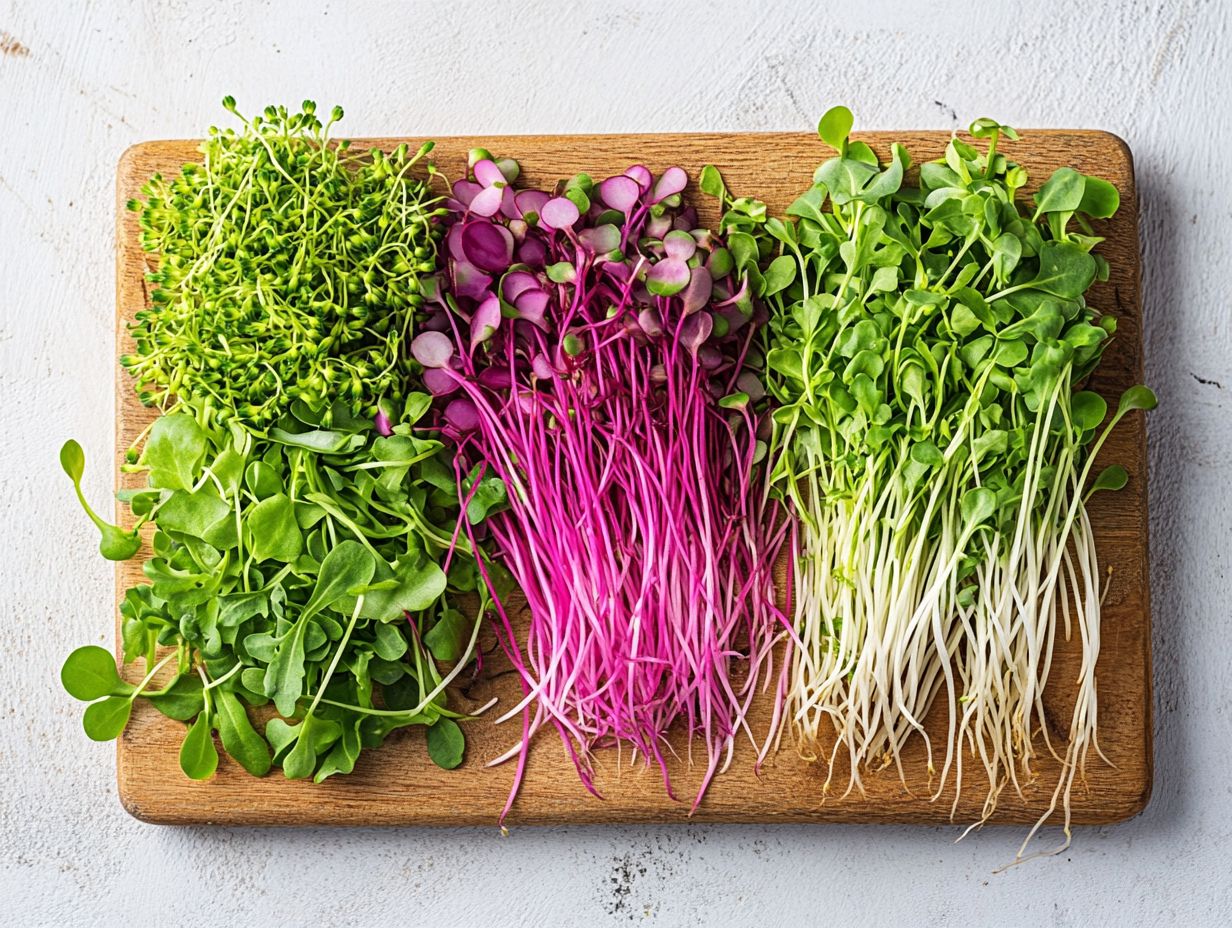
Cilantro microgreens have an unmistakable flavor and aroma that elevate your dishes while offering numerous health benefits. This makes them a beloved choice among chefs and health enthusiasts.
These vibrant green shoots can be used as a garnish or a key ingredient. They add a fresh, citrusy flair that transforms everything from salads and soups to tacos and rice dishes.
These microgreens are rich in essential vitamins like A, C, and K, along with powerful antioxidants that enhance your overall health.
Regularly incorporating these microgreens into your diet supports optimal digestion and metabolic processes while allowing you to savor their distinctive flavor. For a delicious boost, check out 5 nutritious microgreen varieties for smoothies. It’s no wonder chefs rave about their ability to bring balance and brightness to various cuisines.
6. Broccoli Microgreens
Discover why broccoli microgreens are a must-have superfood for your health! They offer impressive health benefits and concentrated nutrients that may contribute to cancer prevention.
These petite green powerhouses are filled with vitamins C, E, and K, along with a rich assortment of antioxidants that work together to strengthen your body s defenses.
Research shows that the glucosinolates in broccoli microgreens can metabolize into natural compounds that may help fight cancer. Studies have demonstrated a connection between the consumption of these microgreens and a reduced risk of certain cancers. Additionally, you might consider 5 microgreens for enhancing eye health to incorporate into your diet, which could provide substantial health advantages.
Not only do they elevate your culinary creations, but they also offer a treasure trove of nutritional benefits that promote overall wellness.
7. Sunflower Microgreens
Sunflower microgreens are a delightful addition to your plate, offering a nutty flavor and a rich array of nutrients, including essential vitamins and minerals beneficial for your overall health.
These tender greens deliver a satisfying crunch and a fresh, slightly earthy taste that elevates salads, sandwiches, and wraps.
Their vibrant presence enhances the visual appeal of your dishes while transforming them into nutritional powerhouses. They are packed with vitamin E, vital for supporting skin health.
They also provide calcium and iron, promoting bone strength and aiding in red blood cell production. Incorporating sunflower microgreens into your meals is a significant step toward improved wellness.
Don’t miss out on the incredible health benefits of adding these microgreens to your meals today!
8. How to Incorporate Microgreens into Your Diet
Incorporating microgreens into your diet enhances not only the flavor of your meals but also their nutritional value. This offers a straightforward approach to elevating your health benefits through a variety of culinary applications while adhering to dietary guidelines.
These tiny greens are brimming with essential vitamins and minerals, making them an outstanding addition to nearly any dish.
For salads, consider tossing in a handful of peppery arugula microgreens to introduce a zesty kick. You can also opt for delicate pea shoots that bring a gentle sweetness to the mix.
Transform your sandwiches with vibrant radish microgreens, which add not just crunch but also an exhilarating burst of flavor.
When stirred into soups just before serving, these greens elevate the overall taste profile, imparting a freshness and color that are truly visually appealing.
This versatility ensures there s always a way for you to enjoy the benefits of microgreens. Meal prep becomes not only healthier but also far more exciting.
9. Potential Side Effects of Microgreens
While microgreens present a wealth of health benefits, it’s vital to remain mindful of potential side effects. Be particularly aware of the risks of contamination from pathogens like E. coli and salmonella if they are not handled properly.
These nutrient-packed greens, though miniature in size, can pose significant health risks if not sourced from reputable suppliers or stored correctly. Make it a priority to purchase them from certified growers and ensure they are wash thoroughly before indulging.
Pay attention to how you store your microgreens. Keeping them in a cold environment is key to inhibiting bacterial growth. Consuming them promptly after purchase is advisable, and always watch for any signs of spoilage.
You must handle them safely to enjoy their delightful crunch and flavor without risking your health.
10. Are Microgreens Safe for Everyone?
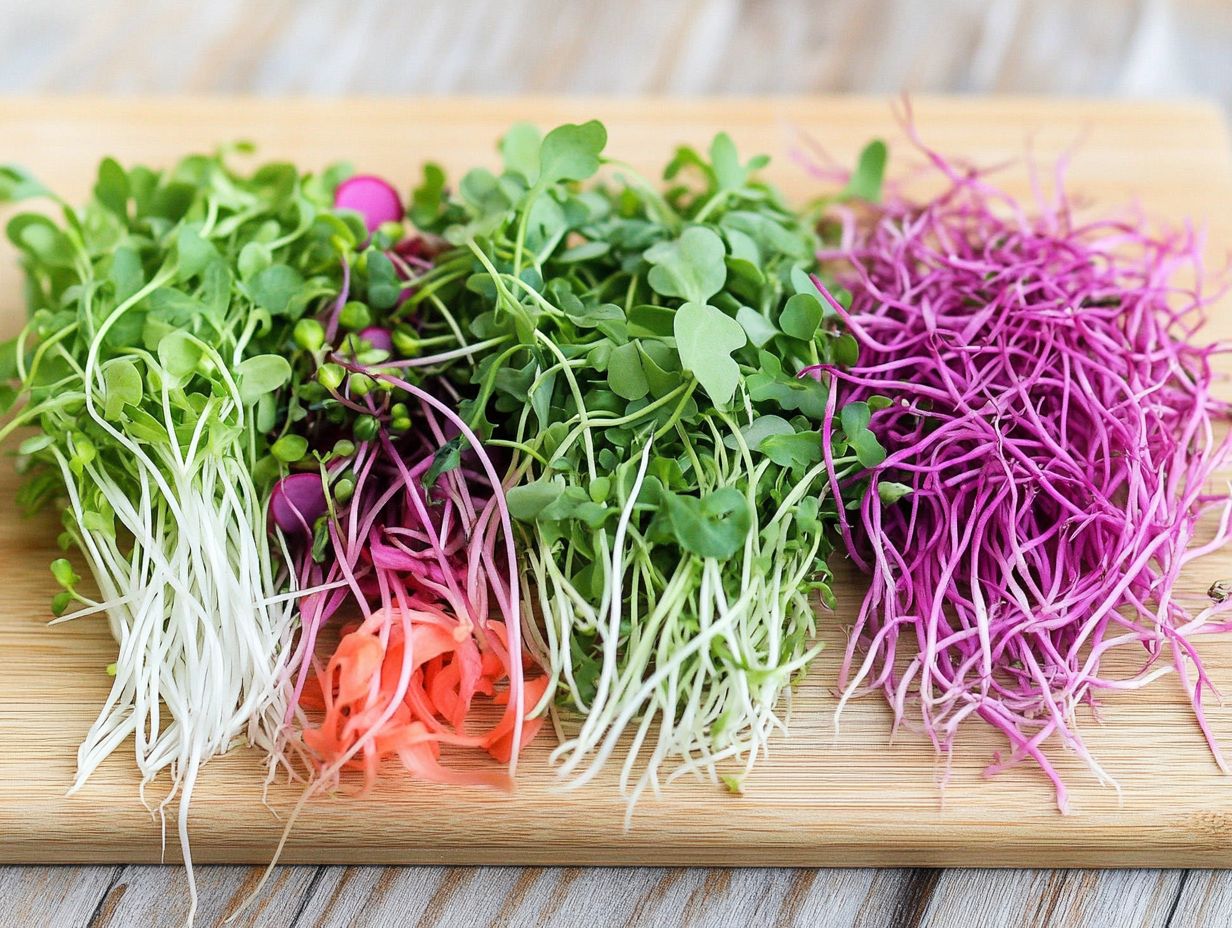
Microgreens generally present a safe option for most individuals. However, if you belong to certain populations such as those with specific health conditions like iron deficiency or heart disease it s wise to consider your dietary guidelines when incorporating them into your meals.
For pregnant women and young children, caution is key when it comes to microgreens. Their immune systems may be more susceptible to foodborne illnesses. It s crucial for these groups to source microgreens from reputable suppliers and, whenever possible, wash them thoroughly to minimize any potential risks.
If you have a compromised immune system, consulting a healthcare professional before adding microgreens to your diet is advisable. The nutritional benefits, such as those from 5 microgreens that help lower blood pressure, should always be balanced against any possible hazards. By taking these precautions, you can savor the vibrant flavors and health benefits of microgreens while ensuring your safety.
11. How to Grow Your Own Microgreens
Growing your own microgreens is not just a delightful and fulfilling endeavor; it elevates your culinary experience while contributing to environmental sustainability through the art of home gardening.
By cultivating these nutrient-packed seedlings, you can reduce your impact on the environment and promote biodiversity. This practice allows you to enjoy fresh greens year-round, regardless of the weather outside.
To embark on this rewarding journey, gather the essential materials:
- Seeds
- Soil
- Trays
- Water
Now, it s time to get your hands dirty. Start by planting the seeds in moistened soil, ensuring they are evenly spaced for optimal growth. Keep the soil consistently damp and provide adequate light to encourage healthy development.
For a bountiful harvest, pay close attention to your watering routine and watch for pesky invaders that could impact your yield. Ultimately, growing microgreens serves a dual purpose: it nourishes your body while nurturing the planet.
Why not try incorporating microgreens into your diet or grow them at home? Enjoy the journey and the benefits they bring!
12. Other Health Benefits of Microgreens
Microgreens are not just nutritious; they bring a wealth of health benefits that can support heart health and help regulate blood sugar levels. This is thanks to their rich supply of antioxidants and other beneficial compounds.
These powerhouses are full of vitamins C, E, and K, essential for maintaining skin health and bolstering the immune system. Research shows that specific microgreens, like radish and broccoli, are packed with glucosinolates, which are natural compounds that may fight cancer. Additionally, 5 ways microgreens promote mental clarity highlight their added benefits for cognitive function.
Their high fiber content aids digestion and supports weight management. This makes microgreens a smart choice for anyone aiming to lead a healthy lifestyle. Regularly adding these vibrant greens, especially the top 5 microgreens for smoothies, to your diet not only helps prevent disease but also enhances overall wellness. They’re a must-have in your meals!
13. Microgreens vs. Sprouts: What’s the Difference?
While both microgreens and sprouts are young plants, they have striking differences in growth, nutritional content, and culinary applications. Each offers unique health benefits and flavor profiles.
Microgreens are typically harvested after just a few weeks. They have a mature leaf structure and a rich array of vitamins and minerals that outperform their sprouted counterparts. Incorporating 5 microgreens to boost energy levels can transform your dishes into vibrant masterpieces, serving as colorful garnishes or flavor enhancers in salads, soups, and sandwiches.
In contrast, sprouts are tiny seedlings harvested even earlier often within days. Their crunchy texture adds a refreshing element to various dishes. Nutritionally, microgreens usually contain a higher concentration of antioxidants and essential nutrients, making them essential for health enthusiasts.
Both microgreens and sprouts play vital roles in a balanced diet. Their distinct culinary uses can truly elevate any meal you create.
14. How to Choose and Store Microgreens
Choosing and storing microgreens with care is crucial for fully enjoying their health benefits while retaining their freshness and flavor.
With just a bit of attention to detail, these vibrant greens can provide a delightful burst of nutrition, color, and taste to your culinary creations. When selecting microgreens, focus on those with bright, lush leaves and sturdy stems; these are indicators of peak freshness.
Store them in a cool, dry location, ideally in a breathable container to prevent moisture buildup.
Keep an eye out for signs of wilting, browning, or sliminess. This proactive approach helps you identify spoilage, allowing you to discard any compromised greens and ensure the quality of the remaining microgreens remains intact.
Frequently Asked Questions
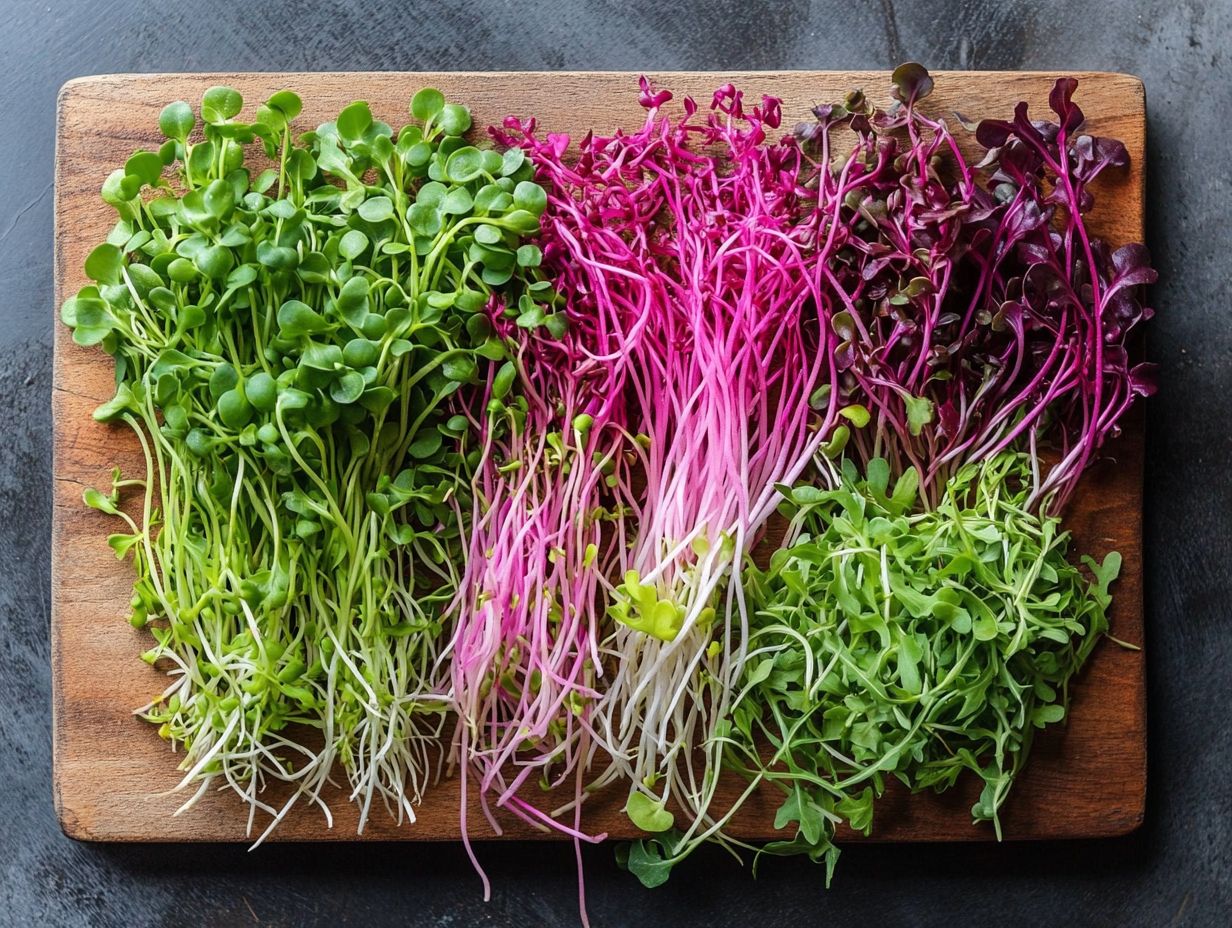
1. What are the top 5 microgreens that aid in digestion?
The top 5 microgreens that aid in digestion are broccoli, kale, arugula, spinach, and cilantro. These leafy greens are rich in enzymes and fiber, which help promote healthy digestion.
2. How do microgreens help with digestion?
Microgreens contain high levels of digestive enzymes, which break down food in the digestive tract and improve nutrient absorption. They also provide a good amount of fiber, regulating bowel movements and promoting healthy digestion.
3. Can microgreens relieve digestive issues?
Yes, certain microgreens like kale and spinach have anti-inflammatory properties that can help relieve digestive issues such as bloating, gas, and constipation. They also contain antioxidants that reduce inflammation in the gut.
4. How can I add microgreens to my meals?
Microgreens can be added to salads, smoothies, sandwiches, or used as a topping for dishes. It’s best to consume them raw for maximum nutrients. You can also grow your own microgreens at home for a fresh and convenient source.
5. Are there any precautions to take when consuming microgreens for digestion?
If you have allergies to specific microgreens, it’s best to avoid them to prevent adverse reactions. Also, make sure to wash your microgreens thoroughly before consuming to avoid potential contamination.
6. Can microgreens aid in weight loss and digestion at the same time?
Yes! Microgreens are low in calories and packed with fiber. They’re a delicious way to lose weight while feeling full and satisfied.
Plus, they help your stomach feel great and keep your bathroom visits regular!

